Spring Hikes on The Bruce Trail
Along the Bruce Trail, spring is the time to slow to a saunter and see, hear and scent nature’s renewal.
Spring is my favourite season. The birds returning, the voices of frogs, the greening of field and forest, the rich organic smell of thawing earth. Last spring, I decided to witness the unfolding season by hiking parts of the Bruce Trail and the Great Trail (aka the Trans Canada Trail) through the rolling landscape of Headwaters. My quest consisted of seven hikes, the first on March 21, the vernal equinox, and the last on June 20, the final full day of spring.
Now, perhaps I should cast my hikes as “saunters” in honour of the eminent conservationist John Muir, who walked through Headwaters in 1864. Muir didn’t like the term hike. Hiking to him was speeding along a trail, largely oblivious to nature. He preferred to describe his style of walking as sauntering. His friend Albert W. Palmer described Muir’s sauntering as walking with reverence through nature, mindful and observant of the flowers, trees and animals. Palmer wrote: “He never hurried. He stopped to get acquainted with individual trees along the way.”
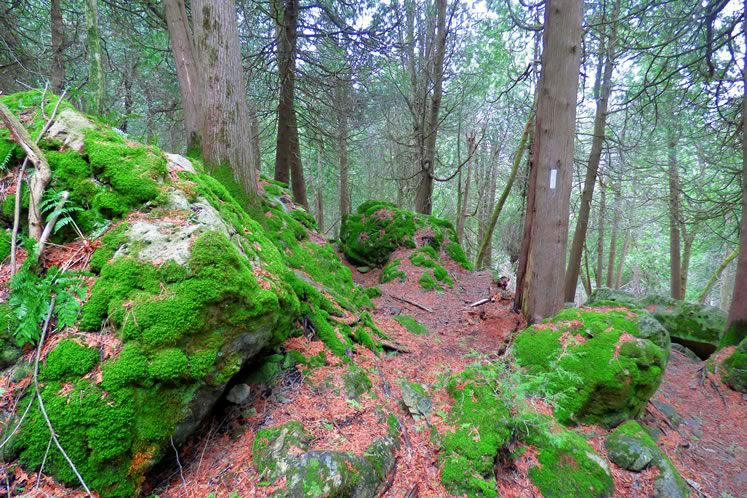
The Bruce Trail in Mono Cliffs Provincial Park, March 20. Photo by Don Scallen.
If sauntering means being conscious of nature in all its manifestations, I saunter too. For me, joy is looking carefully at and thinking deeply about what I see. Trees, bugs, wildflowers and birds exert a pleasant natural friction that slows my progress along a trail. The following descriptions attempt to distill a springtime of sauntering through these hills.
Finally the earth grows softer, and the buds on the trees swell, and the afternoon becomes a wider room to roam in, as the sun moves back from the south and the light grows stronger.
— Mary Oliver, poet, in Owls and Other Fantasies
March 20 · Caledon
Winston Churchill Boulevard to Rockside Road
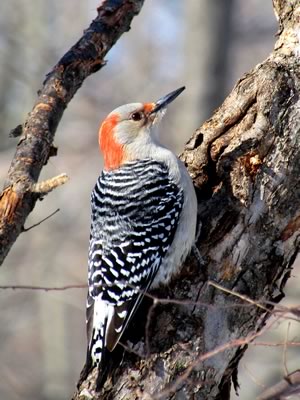
Red-bellied woodpecker, March 20. Photo by Don Scallen.
On this first day of spring, the sun shines on a world brimming with promise. Eleven degrees of revitalizing warmth seep into the woodsy soil, signalling to millions of wildflowers that they are on the cusp of their season of splendour. Wood frogs, at rest under blankets of leaves, feel the spark of life and stretch winter-stiff limbs.
Water, newly liquid, is absorbed greedily by trees and shrubs. The buds of red maple, red elderberry and trembling aspen swell. Brown is still the predominant colour in the woods – the bark of trees and last autumn’s leaves. But the rapidly retreating snow reveals the ascendance of another colour – the welcome green of mosses, ferns and grasses.
A newly arrived turkey vulture sails above on a six-foot wingspan. But most of the birds I see on this hike are hardy sorts that choose to stay with us over winter: crows, blue jays, mourning doves and, always, the irrepressible chickadees. Woodpeckers also keep me company as I walk. I watch a downy woodpecker investigate the fissured bark of an old white pine and a red-bellied woodpecker hunting grubs on the trunk of a dying ash tree. Red-bellied woodpeckers are now common in our hills after expanding north, an example of the constant flux that governs the natural world. I hear, too, the piercing call of a pileated woodpecker. And though I don’t see this magnificent bird, I smile, knowing that its splendid life force is nearby.
After a mild winter I know some amphibians may already be active and, sure enough, I do hear the tentative piping of spring peepers. And in a trailside pool, I find fallen twigs jellied with the eggs of salamanders. Teeming in the water are the fairy shrimp, daphnia and beetles that the larval salamanders will eat.
As I finish this hike in late afternoon, the temperature drops and a north wind builds. I shiver and accept that winter will depart only grudgingly.
April 3 · Caledon
Heritage Road to Forks of the Credit Provincial Park
As I walk with two companions, sporadic rain moistens the wakening landscape. Hepaticas, early blooming wildflowers, will open when they next glimpse the sun. The temperature peaks at 10C.
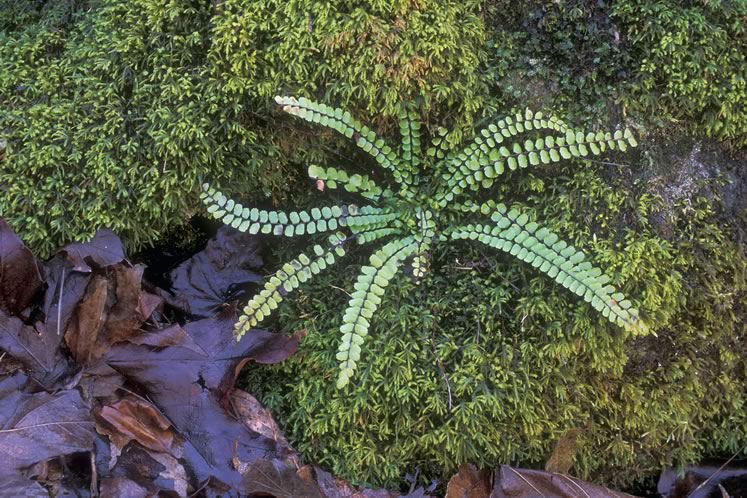
Maidenhair spleenwort, April 3. Photo by Robert McCaw.
The trail leads us down one of the spectacular hills that beckon day trippers to the Forks. We find ourselves in a wonderland of moss-covered boulders, chunks of escarpment dolomite that tumbled down the slope hundreds or even thousands of years ago. The moss glows emerald-green and sprouting from it are exquisite ferns including rock polypody and the evocatively named maidenhair spleenwort. Walking fern – the perfect symbol for the Bruce Trail – also grows here. This unique fern “walks” over mossy stone by extending narrowly triangular fronds that root at the tips.
And then comes the perfect aural accompaniment to the visual magic of this place. The ethereal call of a winter wren rises from a copse of white cedar below us. This tiny bird, mouselike and furtive, has just returned from the south. Though visually unremarkable, its voice is sublime.
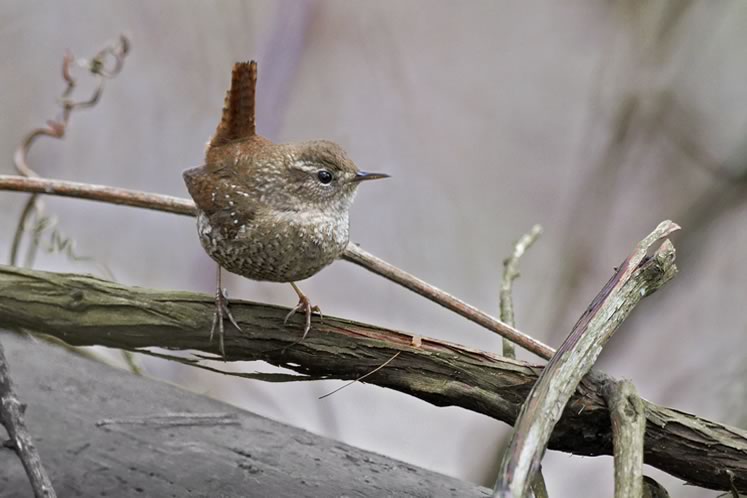
Wren, April 3. Photo by Robert McCaw.
Most other migrants are yet to arrive. Kettles of vultures swirl overhead, however. And kingfishers rattle along a boisterous Credit River, energized by snowmelt and showers. The Credit has an odour, earthy and redolent of living things. I inhale this scent and, for a moment, I’m transported back to my youth, when I spent so many happy hours in and around this modest stream, falling in love with nature.
April 18 · Caledon
Great Trail from Horseshoe Hill Road to Ken Whillans Resource Management Area
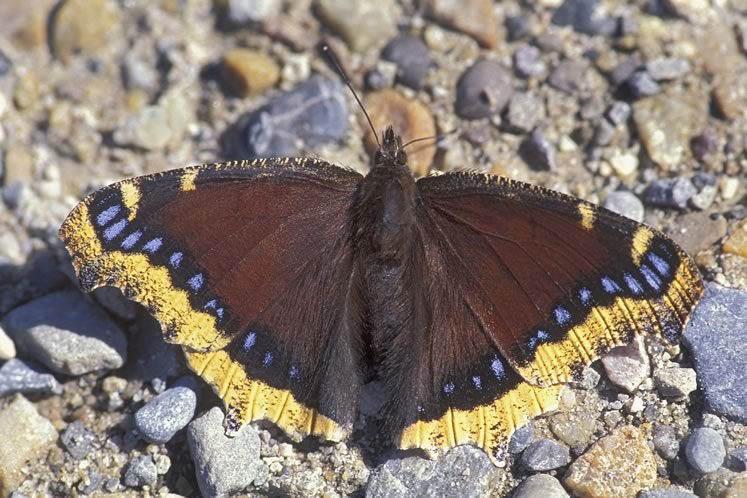
Mourning cloak, April 18. Photo by Robert McCaw.
I walk with three friends on a cool, sun-drenched day. Though the thermometer registers only 10C, butterflies are active. A mourning cloak, having spent the winter under a fold of bark or among the detritus of the forest floor, spreads its wings on the trail, basking in the sun and perhaps feeling an elemental tinge of pleasure. Other butterflies, red admirals, jostle honeybees on the furry golden catkins of pussy willows. Red admirals, unlike mourning cloaks, do not overwinter in Canada. As many birds do, they come to us in spring, migrants from the south.
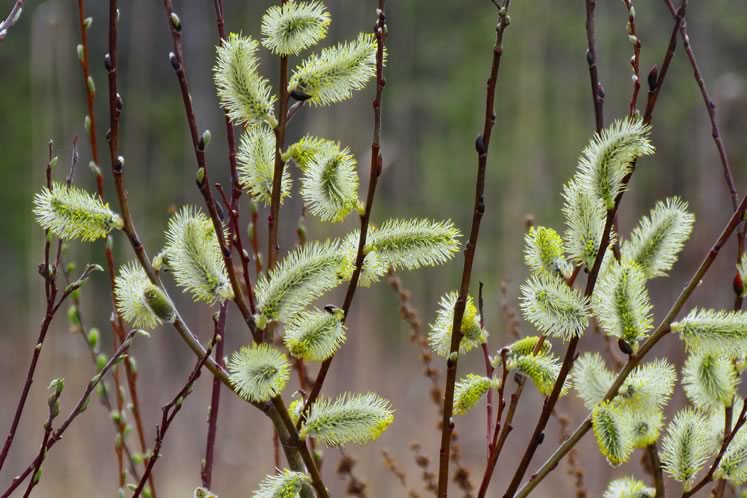
Pussy willows, April 18. Photo by Don Scallen.
Wetlands border the trail in this area, nurturing moisture-loving red maples with frothy blooms that tint the leafless woods a muted scarlet. At our feet the starry flowers of bloodroot are open, parabolas upturned to capture the sun and beckon small bees.
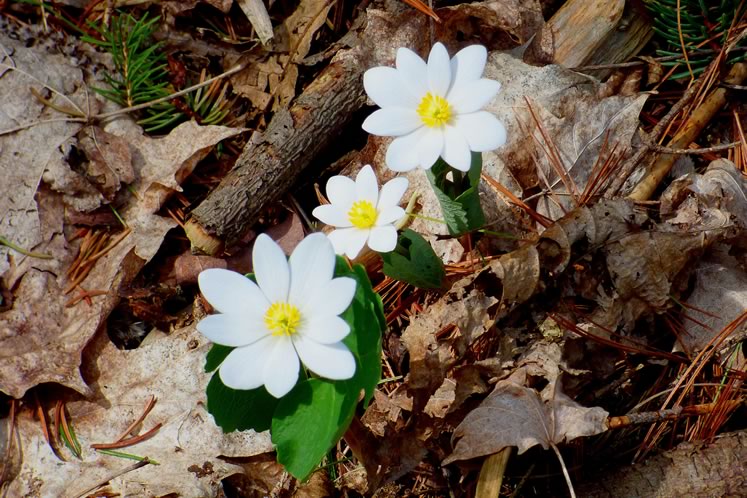
Bloodroot, April 18. Photo by Don Scallen.
One of us hears a faint rustling under a trailside shrub. A garter snake, sinuous and subtle, wends its way through fallen leaves that sound its presence. We’re delighted to spot two more of these common snakes, and we watch as the three of them touch each other gently, forked tongues extended. Garter snakes mate in early spring, so they may be assessing each other’s gender or reproductive readiness. But the curiosity of these snakes extends beyond their interest in one another. As we crouch watching them, they seem unaccountably drawn to us as well. They approach us cautiously with heads held high. Delightful!
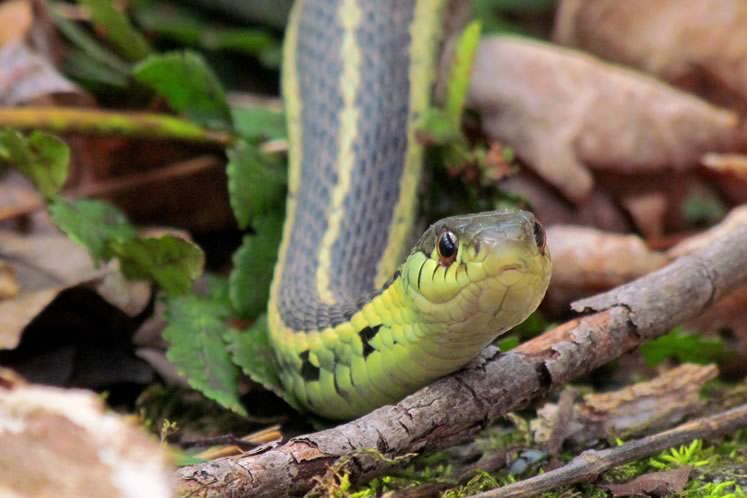
Garter snake, April 18. Photo by Don Scallen.
After leaving the snakes to their springtime affairs, we proceed along the trail and Alexis Buset, one of my companions, spots a beaver. The rest of us miss it, but we admire its impressive home – a large beaver lodge in a swamp beside the trail. The beavers dammed a tiny brook to create this swamp. And the upshot of their eco-engineering project? A home not only for them, but also for minnows and muskrats, herons and wood ducks, red-winged blackbirds and leopard frogs, and myriad other water-loving animals.
May 2 · Mono
Bruce Trail just north of Highway 9
As all who dwell in this northern clime know, spring advances in fits and starts. Today, it is truly cold for May. The thermometer in my car reads a meagre 7C when I park on the Mono- Adjala Townline. Rain falls intermittently, and when I’m beyond the shelter of trees, I’m buffeted by a strong north wind. I question whether I should have ventured out. Predictably, nature answers with an emphatic yes.
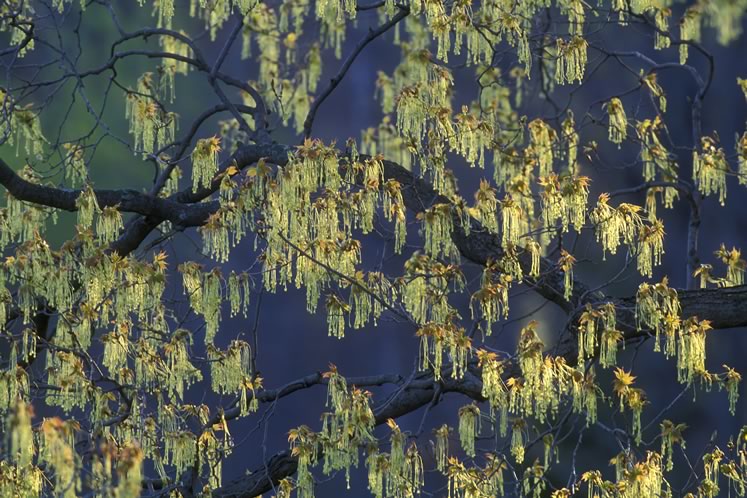
Sugar maple flowers, May 2. Photo by Robert McCaw.
The sugar maples are in full bloom, washing the woodlands in chartreuse. In the understorey, the young burgundy-coloured leaves of chokecherry are emerging and red elderberry shrubs flaunt their white panicled flower heads. Along with the multitudes of sugar maples, the forest contains most of the trees common to our hills. I find lots of yellow birch, resplendently sheathed in golden bark. The dark, cornflake-textured bark of black cherry identifies that species.
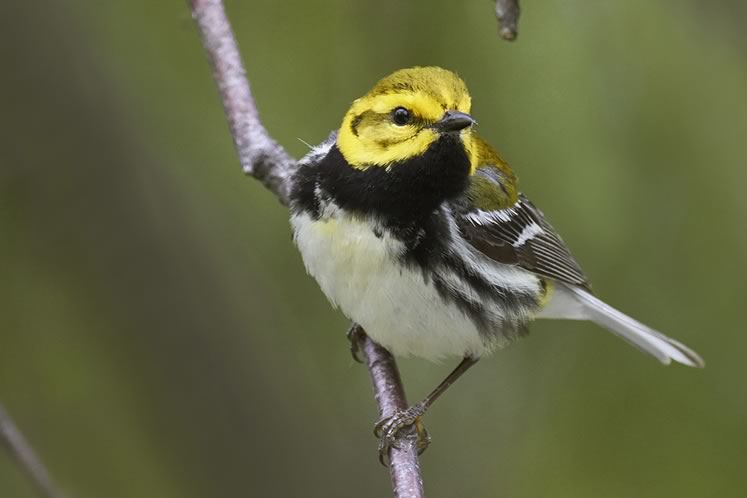
Black-throated green warbler, May 2. Photo by Robert McCaw.
Even though it’s May many migrant birds are yet to return, and the cold today suggests they’re being prudently cautious. I do, however, hear my first warbler of the year – a black-throated green calling from a lofty perch in a hemlock tree. The call of this warbler could be poetically cast as the voice of the hemlock. A lifetime of observation has shown me that, at least in these hills, black-throated green warblers love hemlock above all other trees. It is poignant, then, that this ancient relationship between bird and tree may soon be weakened. Hemlock, like butternut, beech, ash and elm, is now under assault. Its nemesis is an introduced pest called the hemlock woolly adelgid, an aphid-like insect. Ominously, these bugs have recently crossed Ontario’s southern border after devastating hemlocks in the eastern United States.
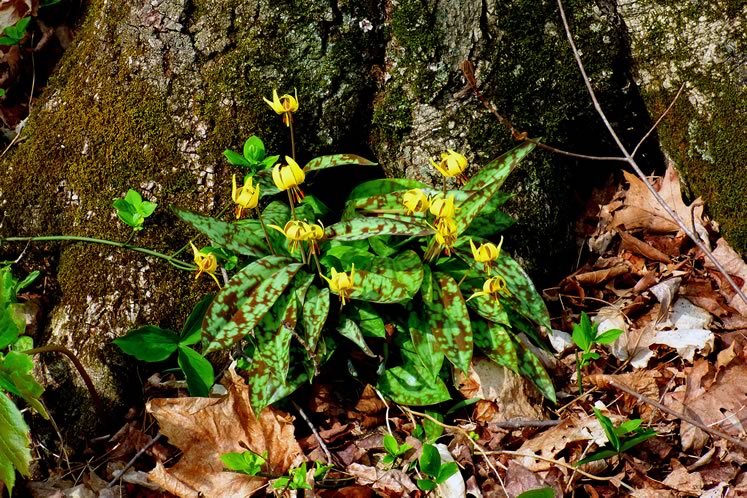
Trout lilies, May 2. Photo by Don Scallen.
Though the songbirds are few, wildflowers abound. Many are closed, protecting their precious nectar and pollen from the inclement weather. But the diversity is wonderful – red and white trilliums, trout lily, toothwort, spring beauty, blue cohosh, wild ginger and squirrel corn.
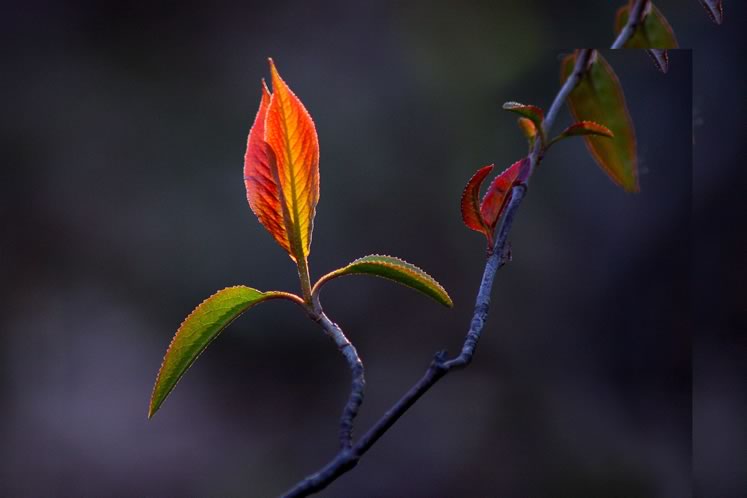
Chokecherry, May 2. Photo by Don Scallen.
As I photograph a lovely spray of Dutchman’s breeches, I’m startled by the warning “sneeze” of a deer. I look up and glimpse three white-tailed deer, flags erect, bounding out of sight. Flowers, deer, the unfurling leaves of trees – my decision to hike on this cold day is well rewarded.
May 16 · Mono
Hockley Valley Provincial Nature Preserve
When I begin my walk, cloud prevails, but soon the sun emerges and the air warms to 18C.
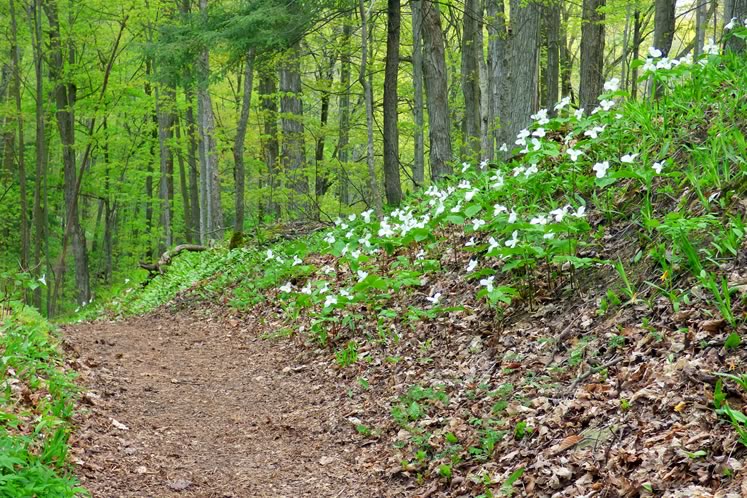
Hockley Valley Provincial Nature Preserve, May 16. Photo by Don Scallen.
Finally, the birds! In recent days thousands of migrants, guided by the stars, have arrived in Headwaters. The forest of the Hockley Nature Preserve is suddenly conversant with their chatter and ringing calls – warblers such as black-throated blues, Nashvilles and redstarts, and other songbirds including red-eyed vireos, scarlet tanagers, house wrens and great-crested flycatchers.
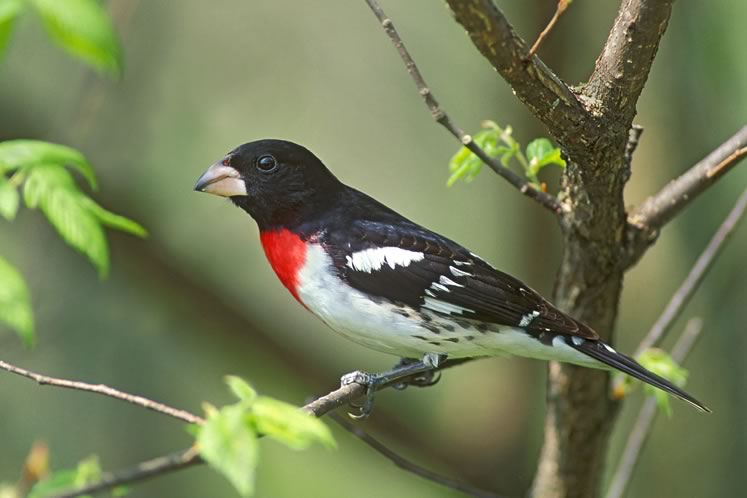
Rose-breasted grosbeak, May 16. Photo by Robert McCaw.
Three male rose-breasted grosbeaks feed on an elm’s newly minted seeds, flashing their shocking crimson bibs as they do. Species of birds that have stayed all winter are already feeding young. I hear hairy woodpecker nestlings squawking for food in a hole high in a dead beech. Woodpecker young, protected from predators within their cavity nests, care not a whit about broadcasting their hunger. Songbird young raised in open nests would never dream of such impudence.
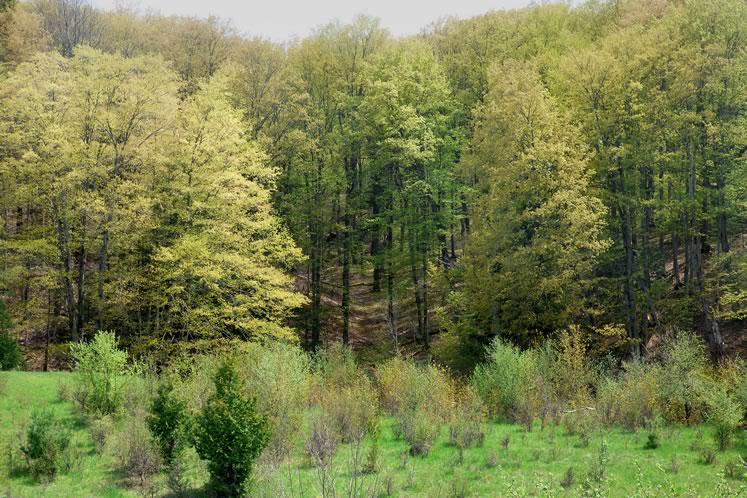
Hockley Valley Provincial Nature Preserve, May 16. Photo by Don Scallen.
Meadow birds in adjacent fields are staking claim to territories. The voices of meadowlarks, song sparrows and field sparrows filter through the trees. Spring has now well and truly arrived, and I exalt in its abundance. But unsurprisingly, I don’t celebrate all of nature’s diversity in equal measure. By the end of my hike, blackflies orbit my head, pinging off my brow as they look for a place to land. I remind myself these tiny vampires help feed the birds, but it would take a soul more charitable than mine to love them.
May 30 · Mono
Mono Cliffs Provincial Park
I walk for most of this day under a canopy of azure skies revelling in a verdant landscape cloaked in fresh new leaves. Later in the afternoon a thunderstorm rolls in, washing the hills with rain.
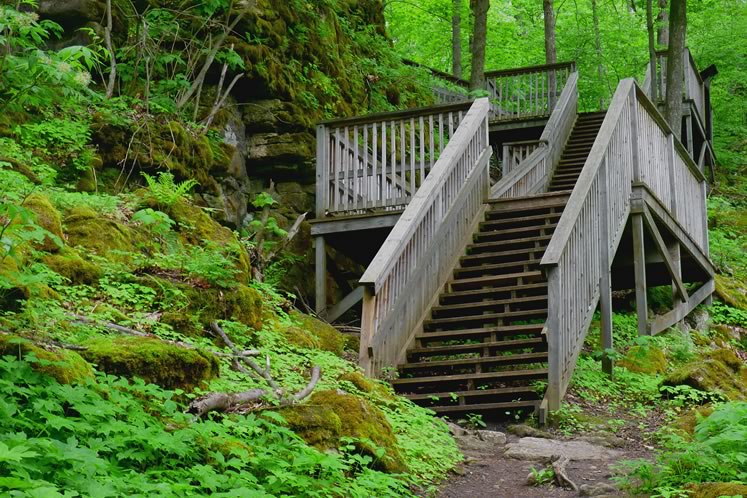
Stairs at Mono Cliffs lookout, May 30. Photo by Don Scallen.
I hike on my own a lot and I enjoy it. Don’t get me wrong, hiking with friends also appeals. But solo hiking allows me to investigate nature at my own pace. Walking alone also allows me to hear nature. People, like chickadees or blue jays, are chatterers. Like birds, we find it very difficult not to talk when in the company of others – talk that can mask the subtler sounds of birds and animals.
I hear the babble of hikers approaching as I listen to the buzzy call of a blue-winged warbler, a bird I haven’t yet seen this spring. I cringe as the boisterous crowd approaches, knowing the warbler will almost certainly fall silent. But the warbler and I get lucky. The hikers veer off on another trail before they meet us.
The blue-winged warbler is one of nine warbler species I encounter on this hike. These “avian butterflies” are more easily heard than seen. They are small and often high in trees or skulking in thick undergrowth. But the effort to see them is worth it. Warblers enchant with diverse colours and patterns – woodland sprites lured from the tropics by the springtime flush of insects, including, yes, those pesky blackflies.
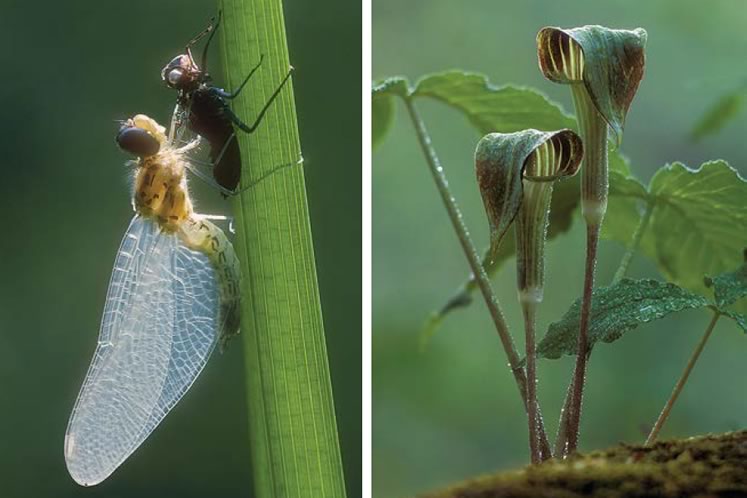
Dragonfly nymph/adult and Jack-in-the-pulpit, May 30. Photos by Robert McCaw.
A highlight of this Mono Cliffs walk is lunch at McCarsten’s Lake. As I eat, I peer into the lake, watching large-mouthed bass torpedo by. I spot smaller pumpkinseed sunfish as well. Green frogs stare unblinking from the shallows and painted turtles bask on logs along the far shore. And then I refocus my gaze to the immediate foreground. A dragonfly is being born, emerging from larval skin clasping a grass stem. It will dry its wings and then join the squadrons of its multihued brethren patrolling the shoreline.
After lunch I return to the woods and enjoy the wildflowers. Trilliums have largely passed, but violets, bane- berry and Canada mayflower are at their height and my favourite childhood wildflower – Jack-in-the-pulpit – delights me in my 59th spring. But all is not well in the woods here. Great swaths of invasive garlic mustard grow where native wildflowers once did. And, as in the rest of the Headwaters, ash and beech are dying.
I smile as the rain stipples the ground at the end of my hike. Pumping my legs up and down the hilly terrain here at Mono Cliffs has been strenuous and I’ve enjoyed the workout. I feel pleasantly fatigued and better than I have for days.
June 12 · Mulmur
Boyne Valley Provincial Park
I’ve noted the appeal of solo walking, but beyond the obvious camaraderie, walking with friends also has undeniable benefits. If those friends have similar inclinations, extra sets of eyes and ears can enrich the experience. I am joined on this saunter by David Williams, a birder whose boundless curiosity embraces an appreciation of other living things. A growing interest in insects has him pointing out some life in miniature I would have otherwise missed. He shows me a spider of a species I’m not familiar with. As I approach it with my macro lens, it flips over and spreads one of its four pairs of legs to threaten me, despite the fact I’m several million times its mass.
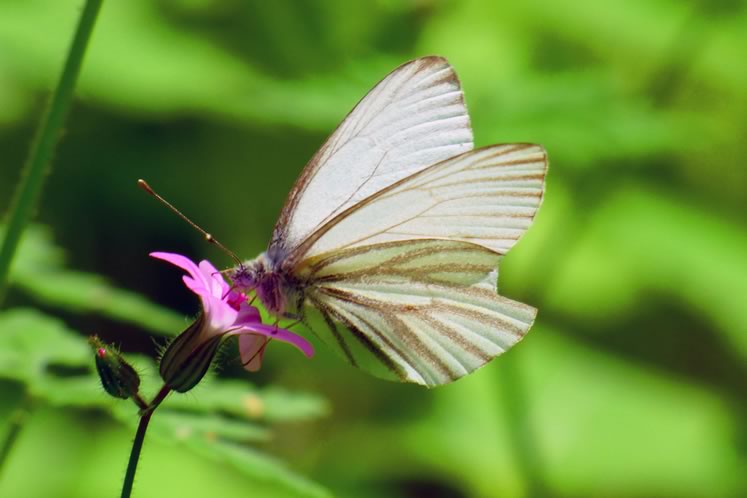
Mustard white butterfly, June 12. Photo by Don Scallen.
In the woods we find shelter from temperatures approaching 30C. Deep shade cast by towering maples keeps the forest floor moist where fronds of cinnamon fern combine with jewelweed to create lush natural gardens.
Late spring is a wonderful time for butterflies. As we walk, they flutter like animated autumn leaves. In sylvan dells, mustard white butterflies and varieties of skippers – small orange butterflies – sip nectar from pink-flowered herb Robert.
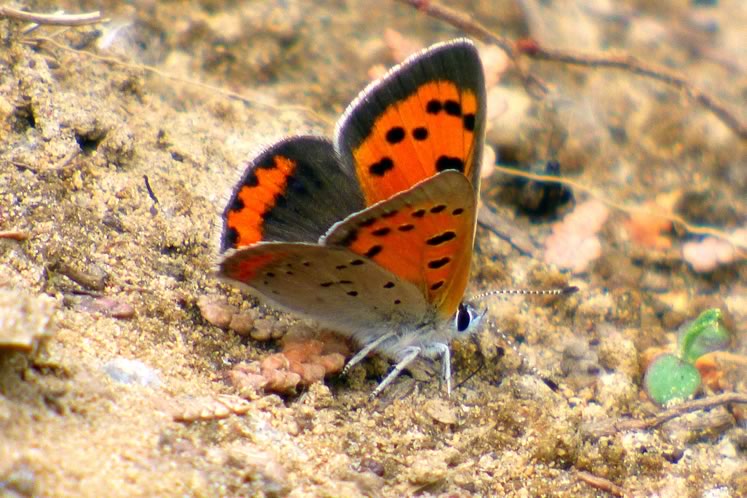
American copper, June 12. Photo by Don Scallen.
Many more butterfly species weave and bob over the meadows: tiger swallowtails, spring azures, silvery blues, ringlets, little wood satyrs and pine elfins. And then American coppers too, a species I haven’t seen in years. These lovely butterflies pack the concentrated beauty of jewels into their tiny wings.
June 20 · Clearview
Noisy River Provincial Park
My final hike of the spring of 2017, on the northern outskirts of Headwaters, is fittingly on the season’s last day. David Williams is again my walking partner. We’ve risen early to catch the dawn chorus of birds. At 6:08 a.m., we park at the end of Concession 8 just north of the Mulmur-Nottawasaga Townline and begin walking toward Noisy River Provincial Park. As we step out of the car, the birds don’t disappoint. Among others, we hear warblers and flycatchers and, to our delight, the rollicking ku, ku, ku, ku, kow! kow! kow! of a yellow-billed cuckoo.
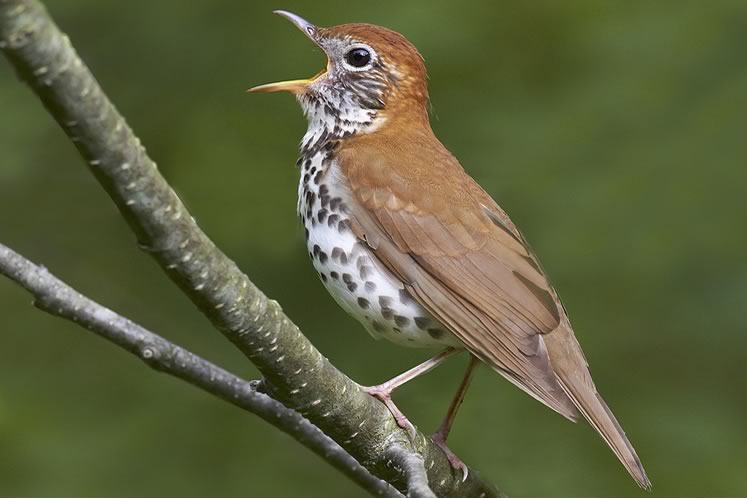
Wood thrush, June 20. Photo by Robert McCaw.
It’s 14C and buggy as we make our way through a young woodland. Piles of stone, old split rail fencing and barbed wire embedded in venerable old maples mark this as a passage through former farmland. I’m struck by how the forest ecology has reasserted itself. Shade-loving wildflowers such as trilliums have returned in profusion. Sprays of graceful maidenhair fern have recolonized, and holly fern, resplendent with deep green, glossy fronds, makes an appearance.
At Noisy River Provincial Park, rock is cleaving off the Niagara Escarpment like icebergs from glaciers, resulting in the deep fissures so characteristic of this striking ridge. We peer, enchanted, into their moist, mossy depths. Cedar trees stand sentinel along their rims, and the fluting call of a wood thrush rings out, soon seconded by the beautiful song of a winter wren.
I reflect that the last time I heard a winter wren was nearly three months ago, when Headwaters was still dressed in the spartan garb of winter. Now, despite its name, this winter wren calls in a new world, lush, verdant and pulsing with life. The wren, like me, has witnessed the unfolding of the season, first singing solo arias, but now merging its voice with a great chorus of birds summoned to our hills by springtime’s bounty.

Noisy River Provincial Park, June 20. Photo by Don Scallen.
In spring’s final hours, I am glad I took on this mission to saunter through the hills and know the season better through its changing moods and ecology. I’ve been party to the springtime flourishing of life in Headwaters and for that I’m elated. One hundred fifty-four springs ago John Muir also experienced that exuberance of life in our hills. In 2018, the nature that inspired him is still just outside our doors, waiting to be embraced with reverence. “Sauntering,” I hope, is in your future.
Related Stories
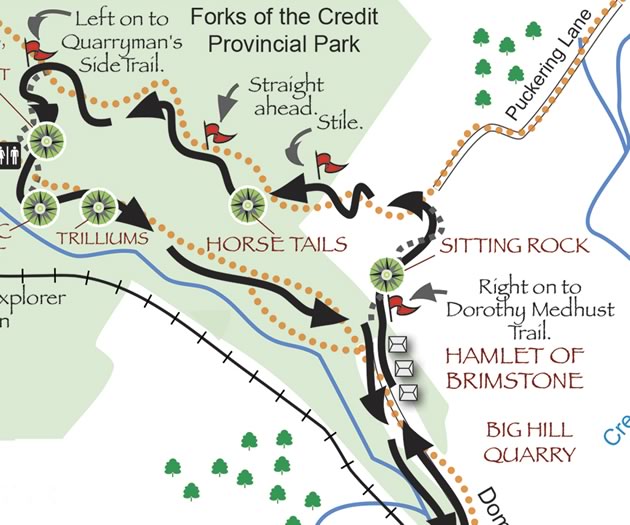
Caledon Hikes
Jun 16, 2015 | | LeisureNicola Ross shows readers how to navigate local Caledon trails, including the Bruce Trail and the Trans Canada Trail, without having to backtrack or arrange to leave a car at a hike’s endpoint.
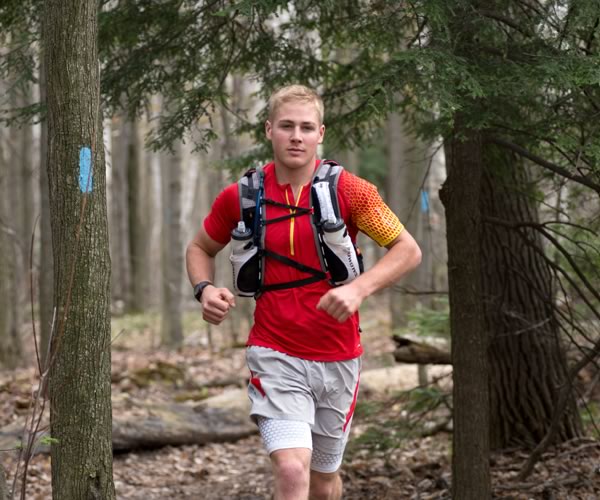
Cody Gillies: End-to-end
Jun 19, 2012 | | Back IssuesCody Gillies aims to run the Bruce Trail in record time – and raise money for sick kids at Headwaters Health Care Centre!
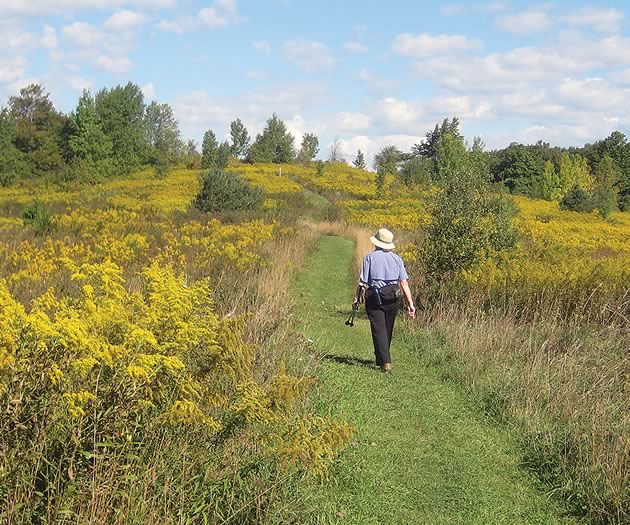
An Audacious Idea – The Bruce Trail Turns 50
Mar 23, 2014 | | Good Sport“What,” Lowes asked, “would you think of a hiking trail winding up the Niagara Escarpment from one end to the other?”
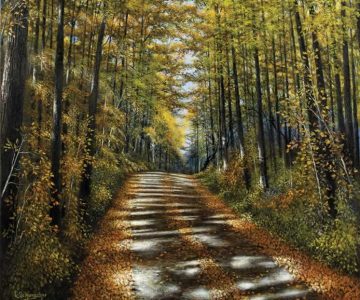
Meetings with Remarkable Trees
Sep 9, 2011 | | EnvironmentWe revel in their beauty, relax in their shade and are calmed by the soothing sound of their leaves soughing in the wind.
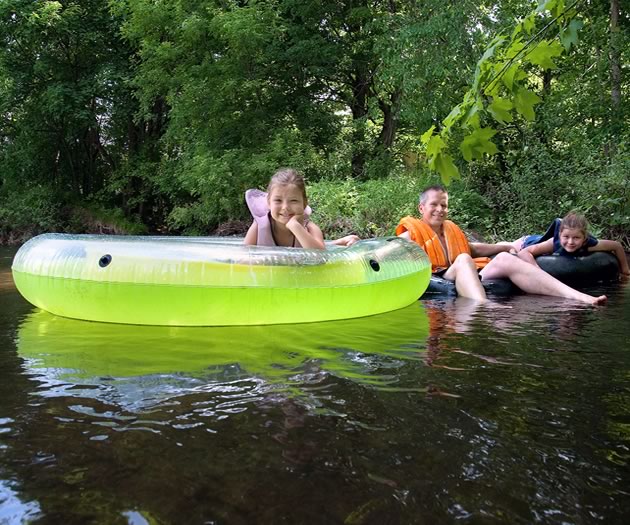
Get the Kids Outside!
Jun 16, 2015 | | LeisureThe Nature Fix: 12 ways to get the kids outside this summer and unleash your own inner kid.
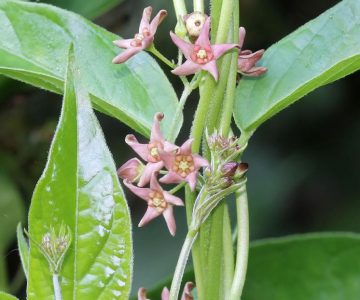
Invasive Species in Our Backyard
Jun 19, 2018 | | EnvironmentThey’re big. They’re strong. And they’re probably here to stay. But keeping them in check will give native plant species a chance.
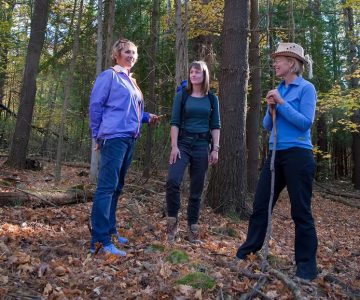
Take a Walk on the Wild Side: Forest Bathing
Mar 26, 2018 | | Good SportSlowing down, tuning in. With forest bathing, the slow movement takes to the woods.



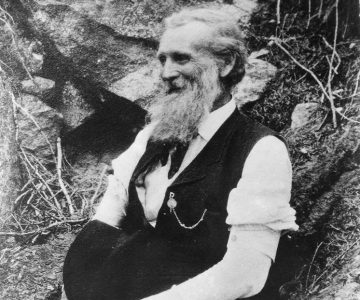






Thanks so much Rosaleen! Nature has long been my salvation. I find solace in its beauty and its stunning complexity. The fascinating life of our fields, forests, streams and wetlands is worthy of our notice and
our respect.
Don Scallen on May 15, 2018 at 9:03 pm |
Thanks so much for taking me with on your sauntering in words and photos, Don.
As always, your narrative is poetic and inspiring. Your reverence for nature, contagious.
The overall experience lifts my spirits.
Rosaleen Egan from Essa Township on May 15, 2018 at 1:20 pm |